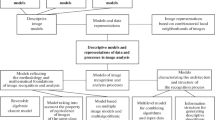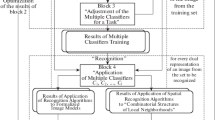Abstract
This article is the fourth in a series of publications devoted to the state of the art and prospects for developing Descriptive Image Analysis, one of the leading and intensively developing fields of modern mathematical image analysis theory. The fundamental problem discussed in the article is to automate information extraction from images necessary for making intelligent decisions. This study is devoted to regularizing the generation of descriptive algorithmic image analysis and recognition schemes. The main result is the definition of a new mathematical structure with the following functional capabilities: 1) solution of an image recognition problem in a given formulation, with given initial data and a scenario that determines the sequence of application of information processing procedures and their iterative loops; 2) construction of descriptive algorithmic schemes for solving a problem with given initial data in the absence of a given scenario; in the case of a successful solution, the fixation of the sequence of procedures and information processing loops that yielded its solution governs the corresponding descriptive algorithmic schemes and scenarios that can be further used to solve the corresponding class of image recognition problems; 3) comparative analysis and optimization of methods for solving image recognition problems via their realization as descriptive algorithmic schemes and scenarios allowed by the structure. The introduced structure is a tool for representing and implementing information processing while solving an image recognition problem for arbitrary formulations, scenarios, models, and solution methods; it can also emulate any descriptive algorithmic scheme and combinations thereof, which are used and generated when solving an image recognition problem. The introduced structure is interpreted as a fundamental model for generating and emulating image recognition procedures. A type characteristic of the introduced information structure for generating descriptive algorithmic schemes is as follows: 1) the set of structure elements consists of two subsets: a) a subset of functional blocks that perform mathematical operations of information processing necessary to implement the used of processing, analysis, and image recognition methods; b) a subset of control blocks for information processing procedures, which verify the logical conditions for branching of processing procedures, whether the rules for stopping information processing are met, etc.; 2) relations given over the elements of the set of the structure, mainly, the partial ordering relations that determine the sequence of execution and methods for combining the functional and control blocks of the structure; 3) these relations, by definition, must satisfy the axioms of the Descriptive Approach to Image Analysis and Understanding. The paper presents the basic definitions associated with the introduction of a new information structure and describes the information processing procedures implemented therein, as well as the main blocks and loops. Block diagrams of the information structure and iteration loops are given. The fundamental importance of the results of the described studies for developing the mathematical theory of image analysis and their scientific novelty are related to formulation of problems and development of methods for modeling the processes for automating image analysis when the input data are poorly formalized representations of images, including spatial data—images and their fragments, image models, incompletely formalized representations, and subsets of combinations thereof. Introduction of a new information structure as a standard structure for a) representation of algorithms for analysis and recognition of 2-dimensional information and representation of procedures for constructing dual representations of images as descriptive algorithmic schemes; b) generation of descriptive algorithmic schemes indicated in (a) will make it possible to generalize and substantiate the known heuristic recognition algorithms, to comparatively analysis them, and to assess their mathematical properties and applied usefulness. The problem of automating the construction and analysis of descriptive algorithmic image recognition schemes is formulated for the first time.


Similar content being viewed by others
REFERENCES
D. V. Alekseevskii, “Structure,” in Mathematical Encyclopedia, Ed. by I. M. Vinogradov (Sov. Entsikl., Moscow, 1984), Vol. 5, p. 249 [in Russian].
V. N. Beloozerov, I. B. Gurevich, and Yu. O. Trusova, “Representation of the ontology of an image analysis domain for optimization of information retrieval,” Pattern Recognit. Image Anal. 15 (2), 358–360 (2005).
A. G. Dragalin “Formal system,” in Mathematical Encyclopedia, Ed. by I. M. Vinogradov (Sov. Entsikl., Moscow, 1984), Vol. 5, p. 249 [in Russian].
I. B. Gurevitch, “Image analysis on the base of reversing algebraic closure technique,” in The Problems of Artificial Intelligence and Pattern Recognition: Proceedings of Scientific Conference with Participation of Scientists from Socialistic Countries (Kiev, May 13–18, 1984). Section 2. Pattern Recognition (Kiev, 1984), pp. 41–43.
I. B. Gurevitch, “The descriptive framework for an image recognition problem,” in Proceedings of the 6th Scandinavian Conference on Image Analysis (Oulu, June 19–22, 1989) (1989), Vol. 1, pp. 220–227.
I. B. Gurevich and I. A. Jernova, “The joint use of image equivalents and image invariants in image recognition,” Pattern Recognit. Image Anal. 13 (4), 570–578 (2003).
I. Gurevich, “The descriptive approach to image analysis. Current state and prospects,” in Image Analysis. 14th Scandinavian Conference, SCIA2005, Joensuu, Finland, June 2005, Proceedings, Ed. by H. Kalviainen, J. Parkkinen, and A. Kaarna; Lect. Notes Comput. Sci. 3540, 214–223 (2005).
I. B. Gurevich and V. V. Yashina, “Computer-aided image analysis based on the concepts of invariance and equivalence,” Pattern Recognit. Image Anal. 16 (4), 564–589 (2006).
I. B. Gurevich, A. V. Khilkov, I. V. Koryabkina, D. M. Murashov, and Yu. O. Trusova, “An open general-purposes research system for automating the development and application of information technologies in the area of image processing, analysis, and evaluation,” Pattern Recognit. Image Anal. 16 (4), 530–563 (2006).
I. B. Gurevich and V. V. Yashina, “Descriptive approach to image analysis: Image models,” Pattern Recognit. Image Anal. 18 (4), 518–541 (2008).
I. B. Gurevich and V. V. Yashina, “Descriptive approach to image analysis: Image formalization space,” Pattern Recognit. Image Anal. 22 (4), 495–518 (2012).
I. B. Gurevich and V. V. Yashina, “Descriptive image analysis. Genesis and current trends,” Pattern Recognit. Image Anal. 27 (4), 653–674 (2017).
I. B. Gurevich and V. V. Yashina, “Descriptive image analysis. Foundations and descriptive image algebras,” Pattern Recognit. Artif. Intell. 33 (12), 1–25 (2019).
I. B. Gurevich and V. V. Yashina, “Descriptive image analysis, Part II: Descriptive image models,” Pattern Recognit. Image Anal. 29 (4), 598–612 (2019).
I. B. Gurevich and V. V. Yashina, “Descriptive image analysis: III. Multilevel model for algorithms and initial data combining in pattern recognition,” Pattern Recognit. Image Anal. 30 (3), 328–341 (2020).
Yu. I. Zhuravlev, “An algebraic approach to recognition and classification problems,” Pattern Recognit. Image Anal. 8, 59–100 (1998).
Funding
The study was partially supported by the Russian Foundation for Basic Research (project no. 20-07-01031).
Author information
Authors and Affiliations
Corresponding authors
Additional information

Igor’ B. Gurevich. Born August 24, 1938. Dr. Eng. (Automatic Control and Electrical Engineering), 1961, National Research University Moscow Power Engineering Institute, Moscow, USSR; Dr. (Mathematical Cybernetics), 1975, Moscow Institute of Physics and Technology (National Research University), Moscow, USSR. Leading Researcher at Federal Research Center Computer Science and Control, Russian Academy of Sciences, Moscow, Russia. Worked from 1960 to present as engineer, researcher, and lecturer in industry, research institutes, medicine, universities, and from 1985 in the USSR/Russian Academy of Sciences. Area of expertise: mathematical theory of image analysis, image mining, image understanding, mathematical theory of pattern recognition, theoretical computer science, medical informatics, applications of pattern recognition and image analysis techniques in biology, medicine, automation of scientific research, and knowledge-based systems. Proposed, tested, and developed with his pupils the Descriptive Approach to Image Analysis and Recognition (DAIA). Within the DAIA, introduced, defined, and investigated a new class of image algebra (Descriptive Image Algebras); introduced, classified, and investigated new types of image models; introduced axioms of Descriptive Theory of Image Analysis; defined and investigated a common model of image recognition process; introduced new formulations of image analysis and recognition problems; introduced and investigated the concept of image equivalence; defined and investigated new classes of image recognition algorithms; introduced, defined, and investigated the image formalization space. The above results were used in developing software kits for image analysis and recognition and for solving important and difficult applied problems of automated bio-medical image analysis. Author of 2 monographs and 305 papers in peer reviewed journals and proceedings indexed in Web of Science, Scopus, and Russian Science Citation Index on Web of Science, 31 invited papers at international conferences, holder of 8 patents. Web of Science: 22 papers; SCOPUS: 72 papers, 214 citations in 125 documents; Hirsh index, 8; Russian Science Citation Index on Web of Science: 84 papers; 426 citations; Hirsh index, 7. Vice-Chairman of National Committee for Pattern Recognition and Image Analysis, Russian Academy of Sciences; Member of International Association for Pattern Recognition (IAPR) Governing Board (representative from Russian Federation), IAPR fellow. PI of 63 R&D projects as part of national and international research programs. Deputy Editor-in-Chief of Pattern Recognition and Image Analysis: Advances in Mathematical Theory and Applications, an international journal of the RAS; member of editorial boards of several international scientific journals; member of program and technical committees of many international scientific conferences. Teaching experience: Moscow State University, Russia (assistant professor); Dresden Technical University, Germany (visiting professor); George Mason University, United States (research fellow). Supervisor of six PhD students and many graduate and master students.

Vera V. Yashina. Born September 13, 1980. Diploma mathematician, Moscow State University (2002). Dr. (Theoretical Foundations of Informatics), 2009, Dorodnicyn Computing Center, Russian Academy of Sciences, Moscow. Leading researcher at Department of Recognition, Security and Analysis of Information, Federal Research Center Computer Science and Control, Russian Academy of Sciences, Moscow, Russia. Worked from 2001 to present in Russian Academy of Sciences. Scientific expertise: mathematical theory of image analysis, image algebras, models and medical informatics. Main results were obtained in mathematical theory of image analysis: defined, classified, and investigated descriptive image algebras with one ring; specified and investigated a new topological image formalization space; defined, classified, and investigated descriptive generating trees. The above results have been applied in biomedical image analysis. Scientific secretary of National Committee for Pattern Recognition and Image Analysis, RAS Presidium Member of Educational Committee of International Association for Pattern Recognition. Participant of many R&D projects as part of national and international research programs. Member of editorial board of Pattern Recognition and Image Analysis. Advances in Mathematical Theory and Applications, an international journal of the RAS. Author of 77 papers in peer reviewed journals and conference and workshop proceedings. Web of Science: 11 papers; Hirsh index, 4; SCOPUS: 31 papers, 98 citations; Hirsh index, 7; Russian Science Citation Index on Web of Science: 42 papers; 97 citations; Hirsh index, 7. Awarded best young scientist several times for papers presented at international conferences. Teaching experience: Moscow State University, Russia. Supervisor of several graduate and master students.
Rights and permissions
About this article
Cite this article
Gurevich, I.B., Yashina, V.V. Descriptive Image Analysis: Part IV. Information Structure for Generating Descriptive Algorithmic Schemes for Image Recognition. Pattern Recognit. Image Anal. 30, 638–654 (2020). https://doi.org/10.1134/S1054661820040161
Received:
Revised:
Accepted:
Published:
Issue Date:
DOI: https://doi.org/10.1134/S1054661820040161
Keywords:
- image analysis
- descriptive image analysis
- mathematical theory of image analysis
- automated information extraction from images
- image recognition
- descriptive algorithmic schemes
- models of image analysis procedures
- image representations
- image models
- image recognition algorithms
- mathematical structures
- information structures
- formal systems




